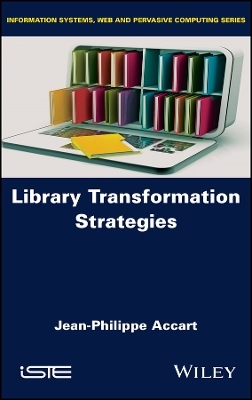
Library Transformation Strategies
ISTE Ltd and John Wiley & Sons Inc (Verlag)
978-1-78630-887-0 (ISBN)
This book is a complete synthesis, a helpful resource for librarians and information professionals that develops four major strategies. The first focuses on understanding the environment and society, with organizational changes affecting cultural institutions (public or private), and the emergence of the library space. The second shows how management methods evolve within them (participatory approach, benevolence, empathy) with an emphasis on project management. The third strategy focuses on the integration of new library tools to better reach audiences. Finally, the fourth develops an essential and indispensable aspect of library marketing.
Jean-Philippe Accart is Head of the Reims campus library of Sciences Po Paris, France. He works in the field of information sciences, with the aim of creating and developing services in this sector and shares his vision for the future of libraries.
Foreword ix
Introduction xiii
Part 1 The Environment and Society 1
Chapter 1 Societal Changes and Libraries 3
1.1 In terms of innovation 3
1.2 In the working world 4
1.3 In the world of professional associations 7
Chapter 2 Economic Changes 9
2.1 An evolving documentary and information activity 9
2.2 The information economy 10
2.2.1 Some figures 10
2.2.2 Free information 11
2.2.3 An economic approach to information and libraries 13
2.3 Information as a public asset 15
2.3.1 Free of charge, information and public libraries 16
2.3.2 Why pay for information? 17
2.4 The Internet and digital technology 19
2.5 Towards new economic models 20
2.6 The theory of knowledge commons 20
Chapter 3 The Evolution of the Library Space 23
3.1 From the perspective of creation and innovation 23
3.2 From the third place to DIY 24
3.2.1 Digital public spaces (Espaces Publics Numériques, EPN) in France 26
3.2.2 Some examples of Fab Labs in American libraries 28
3.3 Learning spaces or learning centers 28
3.4 The Smart Libraries concept 29
3.5 Wellness spaces 31
3.6 Reception areas: a user-oriented approach 33
3.7 The use of the library space 35
3.8 Green libraries 37
Chapter 4 Legal Changes 39
4.1 GDPR: European data protection regulations, as applied to libraries 39
4.1.1 The fields of application 40
4.1.2 Data processing and hosting 41
4.2 Protection of personal data 42
Part 2 Human Resources and Management 45
Chapter 5 New Management Theories Applicable to Libraries 47
5.1 Participatory management 48
5.1.1 The five principles of participatory management 48
5.1.2 The qualities required for participatory management 49
5.2 Management by benevolence or well-treatment 50
5.3 Empathy, a management method? 52
5.4 Change management (CM) 53
5.4.1 The three levels of change management 55
5.5 Project management: theory and applications 55
5.5.1 Project mode operation: two case studies 56
Chapter 6 Some Theory on Management and Leadership 65
6.1 New management methods: Design Thinking, user experience and agile methods 66
6.1.1 Design Thinking 67
6.1.2 User experience (UX) 69
6.2 User power 71
6.3 Setting up and managing an agile project 72
6.3.1 The application of agile methods 73
6.3.2 Agility in libraries 74
6.4 Library management and leadership, constantly redefined concepts 75
Part 3 Library Tools and Technology 77
Chapter 7 The Digital Transformation of Libraries 79
7.1. The library as a service: from catalogues to digital platforms 80
7.1.1 Service platforms 80
7.1.2 Library intranets, information portals and digital repositories 85
7.1.3. Monitoring, business intelligence and curation platforms 88
7.1.4 Social platforms 91
7.2 Digital archiving of documents 95
7.2.1 Document archiving: an overview of open access 96
7.2.2 Dissemination methods 98
7.2.3 European Open Access Policy 100
Chapter 8 Other Technologies for Library Transformation 103
8.1 Blockchain 103
8.2 Augmented/virtual reality in libraries 104
8.2.1 A brief history of augmented reality 105
8.2.2 Augmented reality explained 106
8.3 Artificial intelligence (AI) and robotics 106
Part 4 Marketing 109
Chapter 9 Marketing Dimensions in Libraries 111
9.1 Digital marketing 111
9.2 The user at the heart of transformation 112
9.2.1 Addressing ongoing challenges 112
9.2.2 Capturing the user’s attention online 113
9.3 Adopting a five-step marketing approach 115
9.4 Everyday marketing 118
Chapter 10 The User at the Heart: Mediation 121
10.1 Keeping in touch with the user: mediation 122
10.2 Mediation(s) 124
10.2.1 Library mediation 125
10.2.2 Social mediation 126
10.2.3 Cultural mediation 127
10.2.4 Digital mediation 127
10.2.5 Scientific mediation 128
Chapter 11 The Library’s Digital Identity 131
11.1 Defining identity 131
11.2. From the individual to the group and the library institution 133
11.3 Profiles, behavior and traces on the Internet 135
Chapter 12 Adopting a Library Branding Strategy 139
12.1 Defining the brand concept 140
12.2 Brands and libraries 141
12.3 The brand world 143
Conclusion 147
References 149
Index 153
| Erscheinungsdatum | 08.11.2022 |
|---|---|
| Verlagsort | London |
| Sprache | englisch |
| Gewicht | 553 g |
| Themenwelt | Sozialwissenschaften ► Pädagogik |
| ISBN-10 | 1-78630-887-8 / 1786308878 |
| ISBN-13 | 978-1-78630-887-0 / 9781786308870 |
| Zustand | Neuware |
| Informationen gemäß Produktsicherheitsverordnung (GPSR) | |
| Haben Sie eine Frage zum Produkt? |
aus dem Bereich


